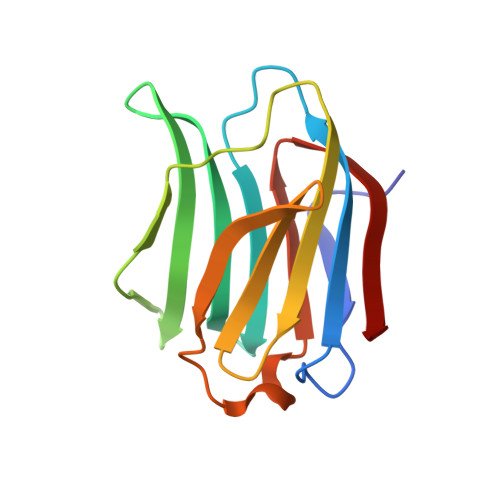Topsy-turvy binding of negatively charged homogalacturonan oligosaccharides to galectin-3.
Zheng, Y., Su, J., Miller, M.C., Geng, J., Xu, X., Zhang, T., Mayzel, M., Zhou, Y., Mayo, K.H., Tai, G.(2021) Glycobiology 31: 341-350
- PubMed: 32909036
- DOI: https://doi.org/10.1093/glycob/cwaa080
- Primary Citation of Related Structures:
6KXA, 6KXB - PubMed Abstract:
Galectin-3 is crucial to many physiological and pathological processes. The generally accepted dogma is that galectins function extracellularly by binding specifically to β(1→4)-galactoside epitopes on cell surface glycoconjugates. Here, we used crystallography and NMR spectroscopy to demonstrate that negatively charged homogalacturonans (HG, linear polysaccharides of α(1→4)-linked-D-galacturonate (GalA)) bind to the galectin-3 carbohydrate recognition domain. The HG carboxylates at the C6 positions in GalA rings mandate that this saccharide bind galectin-3 in an unconventional, "topsy-turvy" orientation that is flipped by about 180o relative to that of the canonical β-galactoside lactose. In this binding mode, the reducing end GalA β-anomer of HGs takes the position of the nonreducing end galactose residue in lactose. This novel orientation maintains interactions with the conserved tryptophan and seven of the most crucial lactose-binding residues, albeit with different H-bonding interactions. Nevertheless, the HG molecular orientation and new interactions have essentially the same thermodynamic binding parameters as lactose. Overall, our study provides structural details for a new type of galectin-sugar interaction that broadens glycospace for ligand binding to Gal-3 and suggests how the lectin may recognize other negatively charged polysaccharides like glycoaminoglycans (e.g. heparan sulfate) on the cell surface. This discovery impacts on our understanding of galectin-mediated biological function.
Organizational Affiliation:
Engineering Research Center of Glycoconjugates Ministry of Education, Jilin Province Key Laboratory for Chemistry and Biology of Changbai Mountain Natural Drugs, School of Life Sciences, Northeast Normal University, 5268 Renmin Street, Changchun 130024, China.















